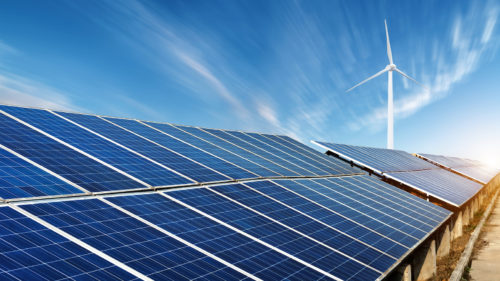Photovoltaic power plants and remote wind turbine generators

A Key Climate Solution is Lifting Off
Virtual power plants can be a key tool in decarbonizing our grid. Here’s how to increase their deployment.
Interest in virtual power plants (VPPs) is at an all-time high. This interest has been fueled by exciting announcements over the past few months including: new research highlighting the role VPPs can play in supporting grid reliability, the official launch of VPP market pilots in Texas, and — just last week — the publication of the Department of Energy’s (DOE) assessment of the state of VPP deployment today and what it will take to achieve commercial “liftoff.” VPPs are already demonstrating that the excitement is warranted, as they increasingly demonstrate the ability to provide an array of grid and customer benefits highlighted in the DOE Liftoff Report including resource adequacy; affordability; reliability and resilience; decarbonization and air pollution reduction; transmission and distribution (T&D) infrastructure relief; community empowerment; and versatility and flexibility.
What is a VPP?
A virtual power plant (VPP) is a collection of small-scale energy resources that, aggregated together and coordinated with grid operations, can provide the same kind of reliability and economic value to the grid as traditional power plants. At its core, a VPP is comprised of hundreds or thousands of households and businesses that offer the latent potential of their thermostats, electric vehicles (EVs), appliances, batteries, and solar arrays to support the grid. Read Clean Energy 101: Virtual Power Plants to learn more.
Virtual power plants are emerging onto the scene as power sector decarbonization continues to build momentum. The initial VPP offerings and programs that are rolling out across the country represent the leading edge of a major emerging resource on the power grid. If we can meet the trajectory for deployment laid out in the DOE Liftoff report, VPPs could triple in scale to 80–160 gigawatts by 2030. And, if deployed and operated with an eye toward reducing emissions, VPPs could be a powerful tool for reducing power sector emissions.
Ensuring that we maximize the carbon impact of this emerging resource requires detailed insight into the specific ways they might operate to reduce emissions. To understand how VPPs decarbonize the grid, we’re developing a framework for evaluating VPPs’ decarbonization potential, building on a foundation of research on grid-interactive buildings and demand flexibility.
Three ways VPPs can support decarbonization
1. Decrease dispatch of fossil-fuel power plants
VPPs can reduce carbon emissions from the power sector by shifting demand away from hours when the grid conventionally relies on its highest-emissions units. Instead, the same demand can be shifted toward times of day when renewables are abundant (e.g., shifting to solar sources during daylight hours).
2. Empower a more rapid transition to low-carbon energy resources
Over time, the impact of VPPs can begin to fundamentally shift the structure of the grid: more demand shifted into high-renewables periods can increase the value of renewables and drive further deployment, while reducing load on peak can defer, replace, or avoid more expensive gas peaker plants. Forward-thinking grid planners will anticipate VPPs’ impact and can build cleaner portfolios with the support of emerging demand flexibility. Recent research by Brattle demonstrated this pathway, showing that VPPs can be deployed at a 40%–60% lower cost compared to a natural gas peaker while also providing for emissions, distribution, transmission, and other benefits.
3. Enable electrification
Finally, VPPs can enable our increasingly electrified economy. Electrifying loads and end-uses, including electrified transportation, could stress the distribution circuits, substations, and transformers that deliver power to end-users and lead to significant costs. By shifting demand to low-demand periods, virtual power plants can avoid stress on these distribution systems and enable more affordable electrification of carbon-based end-uses like transportation or heating.
Each of these pathways represents a way that VPPs can make significant impacts on carbon emissions on our grid.
Strengthening the role of VPPs in our low-carbon energy future
Realizing a future where VPPs can play a key role in supporting grid decarbonization requires operational and structural shifts. Today, virtual power plants are most widely used for infrequent demand response: a seldom-used, last-resort option for grid operators to reduce load at times when the grid is stressed. Enabling a widespread deployment and a broader range of VPP uses is key to unlocking their decarbonization potential across all three pathways, with actions including:
- Expanding distributed energy resource (DER) adoption and VPP enrollment. The first step to unlocking climate impacts from VPPs is to increase VPP capacity. Utilities, regulators, and state energy offices have an opportunity to ensure that households and businesses are using available incentives to deploy DERs that can be aggregated into VPPs and that VPP programs and incentives are set up to support the integration of new DERs. This is especially critical given that consumer incentives available through the Inflation Reduction Act (IRA) to electrify homes and businesses have the potential to accelerate adoption, and integrating new DERs into VPPs is an opportunity to ensure they can be orchestrated to provide value to the grid.
- Enabling VPPs to provide multiple services to the grid. Utilities and grid operators can support maximizing the economic and emissions impact of VPPs by enabling them to provide frequent, flexible services. Policies, programs, and market rules can be designed to ensure that there are few barriers to VPPs providing multiple services.
- Integrating VPPs as a dispatchable, flexible resource in planning. VPPs are a tool that grid planners can deploy today as they design future clean energy portfolios. Utility planning and procurement processes should include VPPs as a candidate resource, and both grid-scale and distribution system planning processes can recognize the value that VPPs can provide to reduce system costs.
These are just initial steps toward VPPs providing decarbonization impacts, laying the foundation for them to play a role in supporting a cleaner, lower-carbon grid.